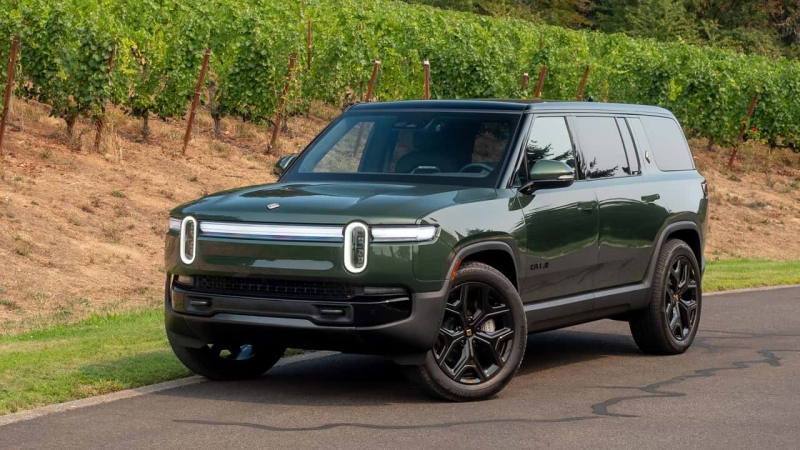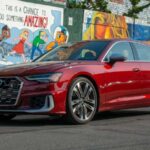The R1S is still a great SUV, but tougher competition has exposed more of its weak points.
Victoria Scott / Motor1
Rivian’s R1S is essentially all-new for 2025, but you’d be forgiven for not knowing that by looking at it. It’s got new batteries, new motors, new software, and even new wiring, but the sheet metal is virtually untouched—it’s still the same friendly two-box design from 2022.
What has changed is the R1S’s competition. When it was new, the R1S was basically the only way to get an electrified (standard) three-row SUV; Now, it competes directly against an ever-growing segment of vehicles from EV upstarts and legacy manufacturers, and it makes the R1S a tougher sell. For 2025, the R1S now costs $75,900, which means a base model is priced roughly the same as a top-of-the-line Kia EV9 GT-Line, one of its biggest competitors.
| Quick Specs | 2025 Rivian R1S Dual Max |
| Motor | Dual (Front / Rear) |
| Output | 665 Horsepower / 829 Pound-Feet |
| Range | 410 Miles |
| Base Price / As Tested | $77,800 / $100,950 |
| On-Sale Date | Now |
Buyers of the base model get the same power as before: boatloads. The standard dual-motor drivetrain pumps out a whopping 533 horsepower and 615 pound-feet of torque, vastly more than the 379-horsepower EV9. It only gets faster from there. Upgrade to the Performance package ($5,000, equipped on my test vehicle) and the same pair of motors produce 665 hp and 829 lb-ft.
Rivian also offers a tri-motor with 850 hp and a quad-motor version with 1,025 hp, but the quad-motor R1Ss won’t hit the streets until next year. Those are promised to pull ten-second quarter miles and hit 60 miles per hour in 2.5 seconds. For my purposes, 665 horsepower was plenty.
For supplying juice to those in-house-designed motors, Rivian offers three battery sizes: A 92.0-kilowatt-hour Standard, a 109.0-kilowatt-hour Large, and a 141.0-kilowatt-hour Max. The battery chemistries and actual capacities are different from the previous R1S, but that’s primarily to help Rivian turn a profit, not to radically change the driving experience of the car.
As far as things buyers will notice, the range varies from a quite-good 258 miles to an outstanding 410 miles, depending on the battery and vehicle specification chosen. My test vehicle was a Dual Max, which offers the full 410 miles of range; This handily bests the Tesla Model X’s 335 miles and the EV9’s 304 miles. Replenishing times are also excellent, with Large and Max packs offering a 220-kilowatt maximum charging rate on DC fast-chargers, translating to 140 miles of range in just 20 minutes.
Buyers should note that price climbs quickly with larger, faster batteries, though. The R1S Dual Max starts at $89,900, but as-tested, the R1S I drove cost $100,950—more than a much-faster Model X Plaid and rapidly approaching the sticker on a Mercedes-Benz EQS SUV ($105,550).
This is where comparison shopping the R1S starts to show weaknesses. For buyers who value off-road ability, the R1S is unrivaled by any EV short of the Hummer—36 inches of wade depth, 15 inches of ground clearance, 35.8 degrees of approach angle. But on the road, it isn’t quite a premium ride. Despite updated and improved suspension, the R1S rides like an old-school SUV than a modern-day luxury EV. In “normal,” it feels a bit too stiff on less-maintained b-roads. In “soft”, it rides like its rebound rate doesn’t quite match its compression rate. And potholes at speed lead to more cabin vibration than its road-focused electric competition.
The 2025 model is updated to a hydraulic anti-roll system, which works excellently, as body lean in cornering is well-managed. The steering is sharp, and the Dual Max stayed well-planted on full-throttle pulls. Still, because of the suspension tuning, if I were choosing a vehicle for a long road trip I’d be more likely to eye an EV9 or an EQS for overall ride comfort.
Inside the cabin, I appreciated the new software written for the 15.6-inch infotainment screen and 12.3-inch driver gauge cluster. Response times are excellent, and graphics for changing drive modes and entering menus are crisply animated. The electric-dimming roof-spanning skylight equipped on my Dual Max was gorgeous and worked well, when dimmed, at keeping most of the heat out of the interior despite 100+ F temps outside. The synthetic leather upholstery feels nice enough, the new in-house premium audio system blasts tunes with clarity, and the woodgrain trim is a thoughtful touch. It’s pleasant when parked.
Actually driving and interacting with the R1S’s cabin, however, is a different story. Rivian has persisted with its virtually button-free philosophy for 2025, and the R1S suffers greatly for it. This anti-tactile ethos applies to things such as mirror and steering column adjustments, climate control, and even the aim of the air vents, which are controlled by dragging icons on the 15.6-inch center screen. Even tech-centric Lucid doesn’t relegate climate control aim to its touchscreen.
While minimalism has its place, the R1S’s single-minded insistence on a screen-centric cabin is frustrating. It’s also at odds with its off-road audience: I shouldn’t need to remove my gloves after a long day skiing to re-aim my heat towards my hands. The NFC card “key” also gave me troubles, even on my short test drive, as the vehicle didn’t recognize I’d left it in the center console sometimes when I’d hop out to take photos.
The R1S also still lacks Android Auto and Apple CarPlay functionality, although 2025 models offer a $149/year Connect+ subscription, which offers Apple Music and Spotify integration (as well as thousands of other streaming apps).
This puts the R1S in a strange spot. In 2025 models, Rivian dropped 40 pounds from the wiring, improved its motor and battery engineering, drastically cut the number of computers required on-board, and added hardware that can support semi-autonomous functionality to rival Autopilot and Super Cruise. (The complete semi-autonomous software still isn’t available, although Rivian has added an automatic lane-change feature via an OTA update this summer.)
Buyers won’t notice most of these changes, though, and whatever cost savings the company found haven’t been passed on. With the $55,000 EV9 on the market and the launch dates for the Cadillac Vistiq, Lucid Gravity, and Hyundai’s to-be-named three-row EV all looming, the R1S has a much tougher case to make now than it did two years ago.
Victoria Scott / Motor1
Competitors
- Kia EV9
- Mercedes-Benz EQS SUV
- Tesla Model X
Get the best news, reviews, columns, and more delivered straight to your inbox, daily. Sign up For more information, read our
Privacy Policy and Terms of Use.
Rivian R1S
Motor Dual (Front/Rear)
Battery Lithium-Ion (NCA), 141 Kilowatt-Hours
Output 665 Horsepower / 829 Pound-Feet
Drive Type All-Wheel Drive
Speed 0-60 MPH 3.4 Seconds
Weight 6,000 Pounds (Estimated)
Efficiency 91 MPGe City / 77 MPGe Highway / 84 MPGe Combined
EV Range 410 Miles
Charge Time 10-80% SoC in 30-40 Minutes
Charge Type Up To 220 Kilowatt-Hour DC Fast Charging
Seating Capacity 7
Towing 7,700 Pounds
Wading depth 36 Inches
Ride height 15 Inches (Maximum)
Angle of repose 35.8 Degrees
Departure angle 34.3 Degrees
Cargo Volume 17.6 Cubic Feet / 46.7 Cubic Feet / 105.8 Cubic Feet (Total With Frunk)
Base Price $77,800
As-Tested Price $100,950
On Sale Now



